Do You Need a High Refresh Rate Monitor for Gaming? The world of gaming has evolved dramatically over the years, and with these advancements, the technology we use has become increasingly important. A high refresh rate monitor can significantly enhance your gaming experience, providing smoother visuals and reducing motion blur, which is essential for fast-paced games. Let’s explore why this feature might be a game-changer for your setup.
As gamers seek the most immersive experiences possible, the ability to visualize every frame with clarity becomes a top priority. High refresh rate monitors offer not just an upgrade in performance but also an opportunity to gain a competitive edge, allowing you to react quickly to dynamic in-game events. In a market saturated with options, understanding the benefits of these monitors helps in making informed purchasing decisions.
In today’s fast-paced world, understanding the importance of effective communication in both personal and professional settings cannot be overstated. The ability to express ideas clearly and interact with others effectively is not just a desirable skill; it has become a fundamental necessity in all aspects of life. Whether it’s sending an email, engaging in a conversation, or presenting in front of an audience, communication shapes our relationships and influences our success.One of the key components of effective communication is the ability to listen.
Listening is often overlooked, yet it is just as vital as speaking. When we listen actively, we not only hear the words being spoken, but we also understand the context and emotions behind them. This skill facilitates deeper connections and fosters trust between individuals. For instance, in a business environment, a manager who listens to their team members is likely to gain insights that can lead to better decision-making.
By valuing others’ opinions, managers can create a collaborative atmosphere where everyone feels empowered to contribute.Moreover, non-verbal communication plays a significant role in how messages are conveyed and interpreted. Body language, facial expressions, and eye contact can say a lot more than words. For example, crossing one’s arms might be interpreted as defensiveness, while maintaining eye contact suggests confidence and engagement.

Being aware of these non-verbal cues can enhance our interactions and lead to more effective communication. It is essential to align our verbal messages with our non-verbal signals to avoid mixed messages that can create confusion.Clarity is another crucial element of effective communication. When articulating our thoughts, it’s important to be precise and concise. This is particularly vital in professional settings where ambiguity can lead to misunderstandings and costly mistakes.
Using jargon or overly complex language can alienate the audience, whereas simple and straightforward language helps ensure that the message is understood by all parties involved. Remember, the goal of communication is not just to speak, but to ensure the message is received as intended.On the flip side, it is equally important to adapt our communication style based on the audience.
Different situations and individuals require different approaches. For instance, communicating with a colleague in a formal meeting may require a different tone and level of detail than chatting with a friend over coffee. Being versatile in our communication style demonstrates emotional intelligence and awareness, enabling us to connect more effectively with diverse groups of people.Furthermore, the rise of digital communication has brought about new challenges and opportunities.
Emails, instant messaging, and social media platforms have transformed the way we interact. While these tools provide convenience and efficiency, they can also lead to misunderstandings due to the lack of physical presence and non-verbal cues. It is essential to be mindful of our tone and wording in digital communications, as the written word can easily be misinterpreted. To mitigate this, consider including an emoji or a friendly closing to convey warmth and approachability in your messages.Feedback is an integral part of the communication process.
Giving and receiving feedback can enhance understanding and promote growth. Constructive feedback, when delivered thoughtfully, can provide valuable insights and foster improvement. On the other hand, being open to receiving feedback allows individuals to reflect on their communication style and make necessary adjustments. This reciprocal process not only strengthens relationships but also cultivates a culture of continuous improvement.Conflict resolution is another area where effective communication is paramount.
Disagreements are inevitable in any relationship, whether personal or professional. However, addressing conflicts through open and honest dialogue can lead to resolution and even strengthen the bond between parties. Approach conflicts with a mindset of problem-solving rather than blame, and encourage others to share their perspectives. Active listening during conflicts can help identify the root causes, allowing for more effective solutions.In addition to these aspects, embracing diversity in communication is increasingly important in our globalized world.
Different cultures may have varying communication styles, and being aware of these differences can prevent misunderstandings. For example, while some cultures may value directness and assertiveness, others may prioritize harmony and indirect communication. Being culturally sensitive and adaptable can enhance interactions and create more inclusive environments.Finally, practice is key to mastering effective communication. Like any skill, the more we engage in communication, the better we become at it.
Take the time to reflect on your communication experiences—both successful and challenging—and identify areas for improvement. Seek opportunities to practice public speaking, engage in conversations, and provide feedback to others. By continuously honing our communication skills, we can navigate various situations with confidence and ease.In conclusion, effective communication is a multifaceted skill that plays a crucial role in our daily lives.
From listening actively and conveying messages clearly to adapting our style and embracing diversity, there are countless ways to enhance our communication abilities. By prioritizing these elements and committing to continuous improvement, we can build stronger relationships, foster collaboration, and ultimately achieve greater success in both our personal and professional endeavors. In a world where communication is key, let us strive to be better communicators, paving the way for more meaningful interactions and connections.


